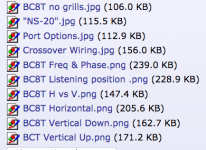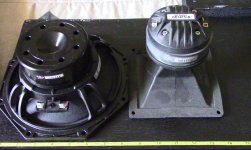Pipes!
Fast (build)!
Loud or Low!
Smooth (with EQ)!
Constant directivity!
Downsized from a large house to an apartment, sold off all the big speakers.
Speakers previously used for studio monitors became home theater speakers.
When the apartment’s second bedroom became the “recording studio”, was short a pair of monitor speakers, and had no speakers capable of doing the small gigs I might still do.
I had retained a pair of B&C 8NDL64-8 and DE14TN on ME20 horns that would fit the bill, but with no work shop to build in, decided to look for “donor cabinets” to house them that would require minimal wood work. Found a pair of Yamaha NS-20T for $30, and the project began.
After the requisite wood butchering, tuning, testing, wiring and listening to the cabinets with a variety of music, find they do quite nicely +/-3dB from 30Hz to 16kHz at levels of up to around 90 dB SPL (C scale, slow) at one meter, about the distance they are from my ears sitting at the desk. Even with the low frequency boost required to dig deep, only a few watts are needed for that level, a 35Hz sine wave tone at 90 dB does not even light up the amp’s lowest level indicator, about 2 watts.
Imaging, dynamics and detail are comparable to good headphones. The 90 degree horizontal polar response is quite uniform, so the sound changes little within the pattern, and avoids side wall “splash”. The vertical pattern is tight, no need for ceiling or desk acoustical treatment.
With a midband one watt one meter sensitivity of around 95 dB, one speaker can put out 120+ peaks when used above 80 Hz, though I’ve yet to “wind them up”- don’t want to upset the other apartment tenants.
Technical Details:
Since I wanted multiple tuning options ranging from around 80 Hz for loud PA use with subs, down to 35 Hz as near field studio monitor using no subs, decided to use standard 1.5” PVC schedule 40 plumbing parts rear mounted for the ports. Using pipe couplings for the “built in” ports, adding 90 degree slip elbows, then pipes from the elbows allows quick tuning changes for the various lower tunings.
The 90 degree elbows insert to about the same depth as the Speakon connectors used, so still allow the cabinet’s back to be placed near a wall.
The Yamaha NS-20T enclosure interior measures 9.75” x 17.5” x 6.5” = 1151.7 cubic inch, .6665 cubic foot, 18.9 liter, less 3 liter for drivers, ports =15.9 L or .5618 cubic feet net. The various tunings (Fb) are roughly:
The various tunings (Fb) are roughly:
76 Hz with no elbows, both pipe coupling ports open
62 Hz with 1 elbow added to one port
60 Hz with 2 elbows added to both ports
48 Hz with two elbows and one 5" tube (past elbow)
44 Hz with elbows and two 5" tubes (past elbow)
40 Hz with elbows and one 5" and one 8" tube (past elbow)
35 Hz with elbows and two 8" tubes (past elbow)
The tunings require various low frequency boosts and high pass filters below tuning for flat response and excursion control, easily implemented with DSP (digital signal processing).
Although using DSP to flatten the response, designed a passive crossover so the speakers could be driven with a single amplifier channel.
Since DSP was a given with the design, the passive crossover was designed primarily for good integration between the B&C 8NDL64-8 and DE14TN on ME20 at the acoustic crossover point of 1600 Hz, which results in a good phase and polar response.
The low crossover used the stock Yamaha NS-20T 1.74MH ferrite core inductor in series with the B&C 8NDL64-8 woofer, a 400 volt 18uF parallel capacitor was substituted for the stock 16uF capacitor for power handling and 1-2 dB more attenuation above 1600 Hz.
The high B&C DE14TN/ME20 horn crossover uses a 2uF 200 volt capacitor ahead of a 25 watt 10 ohm resistor in series with the driver, a 20 ohm 22 watt resistor in parallel. The HF driver polarity is reversed from the woofer. This combination of components flattens the midrange hump of the driver and provides constant directivity compensation, while resulting in a roughly 18 dB per octave transition with no inductor (other than the driver) required.
The graphs below include boundary reflection issues, but give a representative view of the defined coverage pattern and overall response.
Photo descriptions, from left to right as they appear on screen:
"BC8T no grilles" the speakers sitting on the desk without grilles.
"NS-20" the speakers sitting on the desk with grilles.
"Port Options" the various plumbing for different tunings.
"Crossover Wiring" the passive crossover.
“BC8T Freq & Phase” is the response at the desk listening position 31” from the pair of speakers using the 35 Hz tuning, no smoothing, with equalization (InEq) and raw response (InNo).
“BC8T Listening position” displays the response as above with smoothing, similar to what you see in most manufacturer’s specifications.
“BC8T H vs V” shows boundary reflection issues from microphone and driver height differences- if the tests were done in an anechoic chamber, or far enough from boundaries, the response should have been identical for both. The difference is due to raising the speaker from about 42" off the deck to 61", the mic also raised the same distance, at 2 meters (78" distant). Having disposed of my measurement turntable, used the pole mount stand of the speaker as the axis for horizontal rotation, then for the vertical up and down, placed the same speaker on top of the other sideways.
Definitely not ideal, but no listening environment will be either...
“BC8T Horizontal” displays the equalized response on axis (BConEQ) and at 5 degree increments out to 50 degrees off axis, then 10 degree increments out to 90 degree off axis.
“BC8T Vertical Down” displays the equalized response on axis (BConup) and at 5 degree increments to 40 degrees below the high frequency horn axis, horn above the 8” woofer.
“BC8T Vertical Up” displays the equalized response on axis (BConup) and at 5 degree increments to 40 degrees above the high frequency horn axis, horn above the 8” woofer.
“Raw & Xover Response” displays raw (no EQ) measurements done at 18” above the cabinet front, 76 Hz tuning, facing up, laying on a carpeted floor.
BCT is the high frequency horn/driver.
BC8 is the 8” woofer.
Txa20 is the high frequency horn with passive crossover.
BC8x+ is the 8” with passive crossover.
BCxF is the combined response of 8” and HF horn with passive crossover, microphone equidistant between the drivers.
Fast (build)!
Loud or Low!
Smooth (with EQ)!
Constant directivity!
Downsized from a large house to an apartment, sold off all the big speakers.
Speakers previously used for studio monitors became home theater speakers.
When the apartment’s second bedroom became the “recording studio”, was short a pair of monitor speakers, and had no speakers capable of doing the small gigs I might still do.
I had retained a pair of B&C 8NDL64-8 and DE14TN on ME20 horns that would fit the bill, but with no work shop to build in, decided to look for “donor cabinets” to house them that would require minimal wood work. Found a pair of Yamaha NS-20T for $30, and the project began.
After the requisite wood butchering, tuning, testing, wiring and listening to the cabinets with a variety of music, find they do quite nicely +/-3dB from 30Hz to 16kHz at levels of up to around 90 dB SPL (C scale, slow) at one meter, about the distance they are from my ears sitting at the desk. Even with the low frequency boost required to dig deep, only a few watts are needed for that level, a 35Hz sine wave tone at 90 dB does not even light up the amp’s lowest level indicator, about 2 watts.
Imaging, dynamics and detail are comparable to good headphones. The 90 degree horizontal polar response is quite uniform, so the sound changes little within the pattern, and avoids side wall “splash”. The vertical pattern is tight, no need for ceiling or desk acoustical treatment.
With a midband one watt one meter sensitivity of around 95 dB, one speaker can put out 120+ peaks when used above 80 Hz, though I’ve yet to “wind them up”- don’t want to upset the other apartment tenants.
Technical Details:
Since I wanted multiple tuning options ranging from around 80 Hz for loud PA use with subs, down to 35 Hz as near field studio monitor using no subs, decided to use standard 1.5” PVC schedule 40 plumbing parts rear mounted for the ports. Using pipe couplings for the “built in” ports, adding 90 degree slip elbows, then pipes from the elbows allows quick tuning changes for the various lower tunings.
The 90 degree elbows insert to about the same depth as the Speakon connectors used, so still allow the cabinet’s back to be placed near a wall.
The Yamaha NS-20T enclosure interior measures 9.75” x 17.5” x 6.5” = 1151.7 cubic inch, .6665 cubic foot, 18.9 liter, less 3 liter for drivers, ports =15.9 L or .5618 cubic feet net. The various tunings (Fb) are roughly:
The various tunings (Fb) are roughly:
76 Hz with no elbows, both pipe coupling ports open
62 Hz with 1 elbow added to one port
60 Hz with 2 elbows added to both ports
48 Hz with two elbows and one 5" tube (past elbow)
44 Hz with elbows and two 5" tubes (past elbow)
40 Hz with elbows and one 5" and one 8" tube (past elbow)
35 Hz with elbows and two 8" tubes (past elbow)
The tunings require various low frequency boosts and high pass filters below tuning for flat response and excursion control, easily implemented with DSP (digital signal processing).
Although using DSP to flatten the response, designed a passive crossover so the speakers could be driven with a single amplifier channel.
Since DSP was a given with the design, the passive crossover was designed primarily for good integration between the B&C 8NDL64-8 and DE14TN on ME20 at the acoustic crossover point of 1600 Hz, which results in a good phase and polar response.
The low crossover used the stock Yamaha NS-20T 1.74MH ferrite core inductor in series with the B&C 8NDL64-8 woofer, a 400 volt 18uF parallel capacitor was substituted for the stock 16uF capacitor for power handling and 1-2 dB more attenuation above 1600 Hz.
The high B&C DE14TN/ME20 horn crossover uses a 2uF 200 volt capacitor ahead of a 25 watt 10 ohm resistor in series with the driver, a 20 ohm 22 watt resistor in parallel. The HF driver polarity is reversed from the woofer. This combination of components flattens the midrange hump of the driver and provides constant directivity compensation, while resulting in a roughly 18 dB per octave transition with no inductor (other than the driver) required.
The graphs below include boundary reflection issues, but give a representative view of the defined coverage pattern and overall response.
Photo descriptions, from left to right as they appear on screen:
"BC8T no grilles" the speakers sitting on the desk without grilles.
"NS-20" the speakers sitting on the desk with grilles.
"Port Options" the various plumbing for different tunings.
"Crossover Wiring" the passive crossover.
“BC8T Freq & Phase” is the response at the desk listening position 31” from the pair of speakers using the 35 Hz tuning, no smoothing, with equalization (InEq) and raw response (InNo).
“BC8T Listening position” displays the response as above with smoothing, similar to what you see in most manufacturer’s specifications.
“BC8T H vs V” shows boundary reflection issues from microphone and driver height differences- if the tests were done in an anechoic chamber, or far enough from boundaries, the response should have been identical for both. The difference is due to raising the speaker from about 42" off the deck to 61", the mic also raised the same distance, at 2 meters (78" distant). Having disposed of my measurement turntable, used the pole mount stand of the speaker as the axis for horizontal rotation, then for the vertical up and down, placed the same speaker on top of the other sideways.
Definitely not ideal, but no listening environment will be either...
“BC8T Horizontal” displays the equalized response on axis (BConEQ) and at 5 degree increments out to 50 degrees off axis, then 10 degree increments out to 90 degree off axis.
“BC8T Vertical Down” displays the equalized response on axis (BConup) and at 5 degree increments to 40 degrees below the high frequency horn axis, horn above the 8” woofer.
“BC8T Vertical Up” displays the equalized response on axis (BConup) and at 5 degree increments to 40 degrees above the high frequency horn axis, horn above the 8” woofer.
“Raw & Xover Response” displays raw (no EQ) measurements done at 18” above the cabinet front, 76 Hz tuning, facing up, laying on a carpeted floor.
BCT is the high frequency horn/driver.
BC8 is the 8” woofer.
Txa20 is the high frequency horn with passive crossover.
BC8x+ is the 8” with passive crossover.
BCxF is the combined response of 8” and HF horn with passive crossover, microphone equidistant between the drivers.
Attachments
-
 BC8T no grills.jpg106 KB · Views: 665
BC8T no grills.jpg106 KB · Views: 665 -
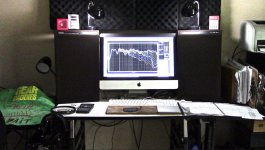 "NS-20".jpg115.5 KB · Views: 675
"NS-20".jpg115.5 KB · Views: 675 -
 Port Options.jpg112.9 KB · Views: 643
Port Options.jpg112.9 KB · Views: 643 -
 Crossover Wiring.jpg156 KB · Views: 644
Crossover Wiring.jpg156 KB · Views: 644 -
 BC8T Freq & Phase.png239 KB · Views: 647
BC8T Freq & Phase.png239 KB · Views: 647 -
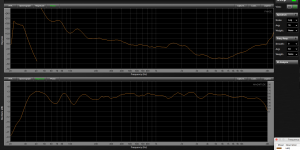 BC8T Listening position .png228.9 KB · Views: 264
BC8T Listening position .png228.9 KB · Views: 264 -
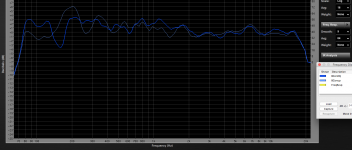 BC8T H vs V.png147.4 KB · Views: 233
BC8T H vs V.png147.4 KB · Views: 233 -
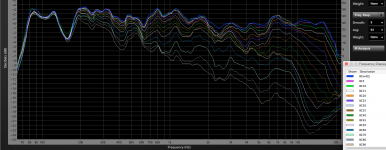 BC8T Horizontal.png205.6 KB · Views: 245
BC8T Horizontal.png205.6 KB · Views: 245 -
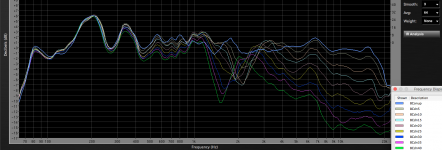 BC8T Vertical Down.png162.7 KB · Views: 231
BC8T Vertical Down.png162.7 KB · Views: 231 -
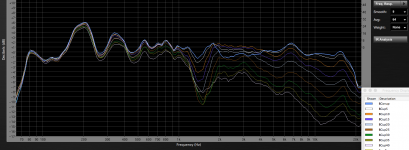 BCT Vertical Up.png171.2 KB · Views: 270
BCT Vertical Up.png171.2 KB · Views: 270
Last edited:
what a killer build! I've got some great PMC monitors in the studio; but all these B&C drivers look amazing.
What are you using for DSP - a DAW plugin ? how much can you smooth out those 350 / 170hz peaks?
What are you using for DSP - a DAW plugin ? how much can you smooth out those 350 / 170hz peaks?
Great project Art ! I love the external, tune-able, ports...
Killer example of how knowledge is king
Killer example of how knowledge is king
Thanks!what a killer build! I've got some great PMC monitors in the studio; but all these B&C drivers look amazing.
What are you using for DSP - a DAW plugin ? how much can you smooth out those 350 / 170hz peaks?
Not much building involved..
Using an old DBX DriveRackPa for DSP, the lower peaks could be smoothed out, but are primarily from reflections.
Your question made me realize explanations of the pictures are needed, I've updated the OP to (hopefully) clarify them.
Also forgot the picture of the drivers included below.
The "BC8T H vs V" shows the change that occurs raising the speaker from about 42" off the deck to 61", with the mic also raised the same distance, at 2 meters (78" distant). Having disposed of my measurement turntable, used the pole mount stand of the speaker as the axis for horizontal rotation, then for the vertical up and down, placed the same speaker on top of the other sideways.
Definitely not ideal, but no listening environment will be either...
Art
Attachments
Last edited:
- Status
- Not open for further replies.
- Home
- Loudspeakers
- Multi-Way
- Hot Rod 8” 2-Way PA/Studio Monitor
